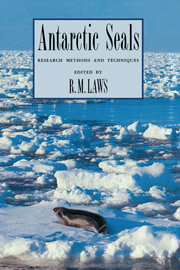Book contents
- Frontmatter
- Contents
- List of contributors
- Preface
- Introduction
- 1 Identification of species
- 2 Estimation of population sizes
- 3 Immobilization and capture
- 4 Marking techniques
- 5 Telemetry and electronic technology
- 6 Behaviour
- 7 Killing methods
- 8 Morphometrics, specimen collection and preservation
- 9 Genetic-based studies for stock separation
- 10 Collection of material for the determination of organochlorine and heavy metal levels
- 11 Age determination
- 12 Reproduction
- 13 Diet
- 14 Bioenergetics
- 15 Development of technology and research needs
- 16 Appendices
- Index
1 - Identification of species
Published online by Cambridge University Press: 05 February 2010
- Frontmatter
- Contents
- List of contributors
- Preface
- Introduction
- 1 Identification of species
- 2 Estimation of population sizes
- 3 Immobilization and capture
- 4 Marking techniques
- 5 Telemetry and electronic technology
- 6 Behaviour
- 7 Killing methods
- 8 Morphometrics, specimen collection and preservation
- 9 Genetic-based studies for stock separation
- 10 Collection of material for the determination of organochlorine and heavy metal levels
- 11 Age determination
- 12 Reproduction
- 13 Diet
- 14 Bioenergetics
- 15 Development of technology and research needs
- 16 Appendices
- Index
Summary
Introduction
The Order Pinnipedia is related to the Carnivora and was formerly classified within that Order. It includes three Families: the Otariidae or eared seals, including fur seals and sea lions; the Odobenidae, including the Atlantic and Pacific walruses; and the Phocidae or true seals, including the Phocinae (northern species) and the Monachtinae (Antarctic ice breeding seals and the elephant seals).
Of seven species of seal considered here, three (elephant seal and two species of fur seal) tend to be sub-Antarctic in distribution, but penetrate further south, particularly in the maritime Antarctic. The other four (Weddell, Ross, crabeater, leopard) are primarily fast ice or pack ice animals. The Weddell (at South Georgia only) and leopard seals also have sub-Antarctic populations. In elephant and fur seals, the males are much larger than the females; in the other species the females are slightly larger than the males (Laws, 1984). There is no sexual dimorphism of colour or pattern. The elephant and fur seals are grey brown, lighter ventrally but with no patterned markings (except small, lighter scars); the other species are all strikingly marked with spots, stripes or blotches, particularly when freshly moulted. Juvenile and adult coats are similar; pups of elephant and fur seals are born with uniform black fur or lanugo; in other species the newborn coat is mottled greyish brown (Weddell), pale ‘milk coffee’ coloured (crabeater) or strongly patterned like the adult (leopard, Ross).
- Type
- Chapter
- Information
- Antarctic SealsResearch Methods and Techniques, pp. 1 - 28Publisher: Cambridge University PressPrint publication year: 1993
- 8
- Cited by



